
IN THIS CHAPTER
Summary: An object whose position-time graph makes a sine or cosine function is in simple harmonic motion. The period of such motion can be calculated.

Key Ideas
 There are three conditions for something to be in simple harmonic motion. All are equivalent. Physics B students do not need to understand the third point, nor the mathematics behind the first:
There are three conditions for something to be in simple harmonic motion. All are equivalent. Physics B students do not need to understand the third point, nor the mathematics behind the first:
1. The object’s position-time graph is a sine or cosine graph.
2. The restoring force on the object is proportional to its displacement from equilibrium.
3. The energy vs. position graph is parabolic, or nearly so.
 The mass on a spring is the most common example of simple harmonic motion.
The mass on a spring is the most common example of simple harmonic motion.
 The pendulum is in simple harmonic motion for small amplitudes.
The pendulum is in simple harmonic motion for small amplitudes.
Relevant Equations
Period of a mass on a spring:

Period of a pendulum:

Relationship between period and frequency:

What’s so simple about simple harmonic motion (SHM)? Well, the name actually refers to a type of movement—regular, back and forth, and tick-tock tick-tock kind of motion. It’s simple compared to, say, a system of twenty-five springs and masses and pendulums all tied to one another and waggling about chaotically.
The other reason SHM is simple is that, on the AP exam, there are only a limited number of situations in which you’ll encounter it. Which means only a few formulas to memorize, and only a few types of problems to really master. Some of these problems can get a little tricky for the Physics C folks, and we’ve included a special section (”The Sinusoidal Nature of SHM”) just for them. But regardless of which exam you’re taking, we hope you’ll agree that most of this material is, relatively, simple.
Simple harmonic motion is the study of oscillations. An oscillation is motion of an object that regularly repeats itself over the same path. For example, a pendulum in a grandfather clock undergoes oscillation: it travels back and forth, back and forth, back and forth . . . Another term for oscillation is “periodic motion.”

Objects undergo oscillation when they experience a restoring force. This is a force that restores an object to the equilibrium position. In the case of a grandfather clock, the pendulum’s equilibrium position—the position where it would be if it weren’t moving—is when it’s hanging straight down. When it’s swinging, gravity exerts a restoring force: as the pendulum swings up in its arc, the force of gravity pulls on the pendulum, so that it eventually swings back down and passes through its equilibrium position. Of course, it only remains in its equilibrium position for an instant, and then it swings back up the other way. A restoring force doesn’t need to bring an object to rest in its equilibrium position; it just needs to make that object pass through an equilibrium position.
If you look back at the chapter on conservation of energy (Chapter 14), you’ll find the equation for the force exerted by a spring, F = kx.This force is a restoring force: it tries to pull or push whatever is on the end of the spring back to the spring’s equilibrium position. So if the spring is stretched out, the restoring force tries to squish it back in, and if the spring is compressed, the restoring force tries to stretch it back out. Some books present this equation as F = −kx.The negative sign simply signifies that this is a restoring force.
One repetition of periodic motion is called a cycle. For the pendulum of a grandfather clock, one cycle is equal to one back-and-forth swing.
The maximum displacement from the equilibrium position during a cycle is the amplitude. In Figure 17.1, the equilibrium position is denoted by “0,” and the maximum displacement of the object on the end of the spring is denoted by “A.”
Figure 17.1 Periodic motion of a mass connected to a spring.
The time it takes for an object to pass through one cycle is the period, abbreviated “T” Going back to the grandfather clock example, the period of the pendulum is the time it takes to go back and forth once: one second. Period is related to frequency, which is the number of cycles per second. The frequency of the pendulum of the grandfather clock is f = 1 cycle/s, where “f” is the standard abbreviation for frequency; the unit of frequency, the cycle per second, is called a hertz, abbreviated Hz. Period and frequency are related by this equation:

A mass attached to the end of a spring will oscillate in simple harmonic motion. The period of the oscillation is found by this equation:

In this equation, m is the mass of the object on the spring, and k is the “spring constant.” As far as equations go, this is one of the more difficult ones to memorize, but once you have committed it to memory, it becomes very simple to use.
A block with a mass of 10 kg is placed on the end of a spring that is hung from the ceiling. When the block is attached to the spring, the spring is stretched out 20 cm from its rest position. The block is then pulled down an additional 5 cm and released. What is the block’s period of oscillation, and what is the speed of the block when it passes through its rest position? |
|
Let’s think about how to solve this problem methodically. We need to find two values, a period and a speed. Period should be pretty easy—all we need to know is the mass of the block (which we’re given) and the spring constant, and then we can plug into the formula. What about the speed? That’s going to be a conservation of energy problem—potential energy in the stretched-out spring gets converted to kinetic energy—and here again, to calculate the potential energy, we need to know the spring constant. So let’s start by calculating that.
First, we draw our free-body diagram of the block.

We’ll call “up” the positive direction. Before the mass is oscillating, the block is in equilibrium, so we can set Fs equal to mg. (Remember to convert centimeters to meters!)
kx = mg
k (0.20 m) = (10 kg)(10 m/s2)
k = 500 N/m
Now that we have solved for k, we can go on to the rest of the problem. The period of oscillation can be found be plugging into our formula.
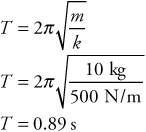
To compute the velocity at the equilibrium position, we can now use conservation of energy.
KEa + PEa = KEb + PEb
When dealing with a vertical spring, it is best to define the rest position as x = 0 in the equation for potential energy of the spring. If we do this, then gravitational potential energy can be ignored. Yes, gravity still acts on the mass, and the mass changes gravitational potential energy. So what we’re really doing is taking gravity into account in the spring potential energy formula by redefining the x= 0 position, where the spring is stretched out, as the resting spot rather than where the spring is unstretched.

In the equation above, we have used a subscript “a” to represent values when the spring is stretched out the extra 5 cm, and “b” to represent values at the rest position.
When the spring is stretched out the extra 5 cm, the block has no kinetic energy because it is being held in place. So, the KE term on the left side of the equation will equal 0. At this point, all of the block’s energy is entirely in the form of potential energy. (The equation for the PE of a spring is ½kx2, remember?) And at the equilibrium position, the block’s energy will be entirely in the form of kinetic energy. Solving, we have


Problems that involve simple pendulums—in other words, basic, run-of-the-mill, grandfather clock-style pendulums—are actually really similar to problems that involve springs. For example, the formula for the period of a simple pendulum is this:

Looks kind of like the period of a mass on a spring, right? In this equation, L is the length of the pendulum, and g is the acceleration attributable to gravity (about 10 m/s2). Of course, if your pendulum happens to be swinging on another planet, g will have a different value.1
One interesting thing about this equation: The period of a pendulum does not depend on the mass of whatever is hanging on the end of the pendulum. So if you had a pendulum of length L with a peanut attached to the end, and another pendulum of length L with an elephant attached to the end, both pendulums would have the same period in the absence of air resistance.
A string with a bowling ball tied to its end is attached to the ceiling. The string is pulled back such that it makes a 10° angle with the vertical, and it is then released. When the bowling ball reaches its lowest point, it has a speed of 2 m/s. What is the frequency of this bowling ball-pendulum? |
|
To calculate the period of this pendulum, we must know the length of the string. We can calculate this using conservation of energy. Then, we’ll convert the period to a frequency.
Before the string is released, all of the bowling ball’s energy is in the form of gravitational PE. If we define the zero of potential to be at the ball’s lowest point, then at that point all the bowling ball’s energy is in the form of KE. We will use a subscript “a” to represent values before the bowling ball is released and “b” to represent values when the bowling ball is at its lowest point.

The height of the bowling ball before it is released, ha, can be calculated using trigonometry.
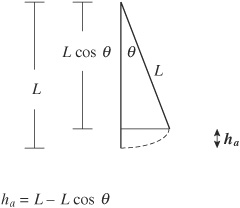
So, getting back to our previous equation, we have

We know θ and we know vb, so we can solve for L.

Now that we know L, we can find the frequency.
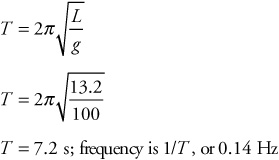
The Sinusoidal Nature of SHM
Consider the force acting on an object in simple harmonic motion: Fnet = −kx.Well, Fnet = ma, and acceleration is the second derivative of position. So the equation for the motion of the pendulum becomes

This type of equation is called a differential equation, where a derivative of a function is proportional to the function itself.
You don’t necessarily need to be able to solve this equation from scratch. However, you should be able to verify that the solution x = A cos(ωt) satisfies the equation, where

(How do you verify this? Take the first derivative to get dx/dt = A ω sin (ω t); then take the second derivative to get –Aω2 cos (ωt). This second derivative is, in fact, equal to the original function multiplied by −k/m.)
What does this mean? Well, for one thing, the position–time graph of an object in simple harmonic motion is a cosine graph, as you might have been shown in your physics class. But more interesting is the period of that cosine function. The cosine function repeats every 2 π radians. So, at time t = 0 and at time t = 2π/ω, the position is the same. Therefore, the time 2π/ω is the period of the simple harmonic motion. And plugging in the ω value shown above, you see that—voila!—

as listed on the equation sheet!
 Practice Problems
Practice Problems1. A basketball player dribbles the ball so that it bounces regularly, twice per second. Is this ball in simple harmonic motion? Explain.
Multiple Choice:
2. A pendulum has a period of five seconds on Earth. On Jupiter, where g ~30 m/s2, the period of this pendulum would be closest to
(A) 1 s
(B) 3 s
(C) 5 s
(D) 8 s
(E) 15 s
3. A pendulum and a mass on a spring are designed to vibrate with the same period T. These devices are taken onto the Space Shuttle in orbit. What is the period of each on the Space Shuttle?
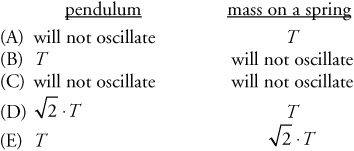
4. A mass on a spring has a frequency of 2.5 Hz and an amplitude of 0.05 m. In one complete period, what distance does the mass traverse? (This question asks for the actual distance, not the displacement.)
(A) 0.05 cm
(B) 0.01 cm
(C) 20 cm
(D) 10 cm
(E) 5 cm
5. Increasing which of the following will increase the period of a simple pendulum?
I. the length of the string
II. the local gravitational field
III. the mass attached to the string
(A) I only
(B) II only
(C) III only
(D) I and II only
(E) I, II, and III
Free Response:
6. A mass m is attached to a horizontal spring of spring constant k. The spring oscillates in simple harmonic motion with amplitude A. Answer the following in terms of A.
(a) At what displacement from equilibrium is the speed half of the maximum value?
(b) At what displacement from equilibrium is the potential energy half of the maximum value?
(c) When is the mass farther from its equilibrium position, when its speed is half maximum, or when its potential energy is half maximum?
 Solutions to Practice Problems
Solutions to Practice Problems1. The ball is not in simple harmonic motion. An object in SHM experiences a force that pushes toward the center of the motion, pushing harder the farther the object is from the center; and, an object in SHM oscillates smoothly with a sinusoidal position–time graph. The basketball experiences only the gravitational force, except for the brief time that it’s in contact with the ground. Its position–time graph has sharp peaks when it hits the ground.
2. B—The period of a pendulum is

All that is changed by going to Jupiter is g, which is multiplied by 3. g is in the denominator and under a square root, so the period on Jupiter will be reduced by a factor of  . So the original five-second period is cut by a bit less than half, to about three seconds.
. So the original five-second period is cut by a bit less than half, to about three seconds.
3. A—The restoring force that causes a pendulum to vibrate is gravity. Because things float in the Space Shuttle rather than fall to the floor, the pendulum will not oscillate at all. However, the restoring force that causes a spring to vibrate is the spring force itself, which does not depend on gravity. The period of a mass on a spring also depends on mass, which is unchanged in the Space Shuttle, so the period of vibration is unchanged as well.
4. C—The amplitude of an object in SHM is the distance from equilibrium to the maximum displacement. In one full period, the mass traverses this distance four times: starting from max displacement, the mass goes down to the equilibrium position, down again to the max displacement on the opposite side, back to the equilibrium position, and back to where it started from. This is 4 amplitudes, or 0.20 m, or 20 cm.
5. A—The period of a pendulum is

Because L, the length of the string, is in the numerator, increasing L increases the period. Increasing g will actually decrease the period because g is in the denominator; increasing the mass on the pendulum has no effect because mass does not appear in the equation for period.
6. (a) The maximum speed of the mass is at the equilibrium position, where PE = 0, so all energy is kinetic. The maximum potential energy is at the maximum displacement A, because there the mass is at rest briefly and so has no KE. At the equilibrium position all of the PE has been converted to KE, so

Solving for vmax, it is found that

So, at a position 1/2 A, the velocity is half its maximum.
Now that we have a formula for the maximum speed, we can solve the problem. Call the spot where the speed is half-maximum position 2.
Write conservation of energy from the maximum displacement to position 2:

The speed v2 is half of the maximum speed we found earlier, or  . Plug that in and solve for x2:
. Plug that in and solve for x2:
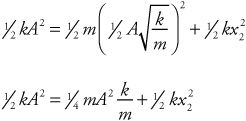
The m’s and the k’s cancel. The result is  or about 86% of the amplitude.
or about 86% of the amplitude.
(b) The total energy is 1/2kA2. At some position x, the potential energy will be 1/2 of its maximum value. At that point, 1/2kx2 = 1/2(1/2kA2). Canceling and solving for x, it is found that

This works out to about 70% of the maximum amplitude.
(c) Since we solved in terms of A, we can just look at our answers to (a) and (b). The velocity is half-maximum at  , or 86%, of A; the potential energy is half-maximum at
, or 86%, of A; the potential energy is half-maximum at  or 71%, of A. Therefore, the mass is farther from equilibrium when velocity is half-maximum.
or 71%, of A. Therefore, the mass is farther from equilibrium when velocity is half-maximum.
 Rapid Review
Rapid Review• An oscillation is motion that regularly repeats itself over the same path. Oscillating objects are acted on by a restoring force.
• One repetition of periodic motion is called a cycle. The maximum displacement of an oscillating object during a cycle is the object’s amplitude. The time it takes for an object to go through a cycle is the period of oscillation.
• Period is related to frequency: T = 1 /f, and f = 1/T.
• When solving problems that involve springs or simple pendulums, be on the lookout for ways to apply conservation of energy. Not every simple harmonic motion problem will require you to use conservation of energy, but many will.
• The position–time graph of an object in simple harmonic motion is a cosine graph. Specifically, the position of the object is found by the equation x = A cos(ωt), where
